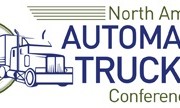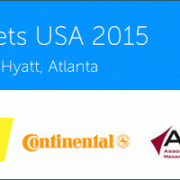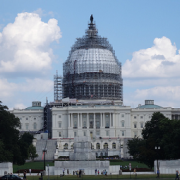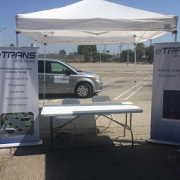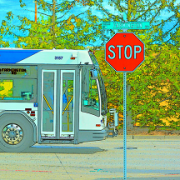Burney Simpson
Riding the bus isn’t usually high-tech but a new app in Silicon Valley designed to make public bus operations more efficient is using Dedicated Short Range Communication (DSRC) to conduct Vehicle-to-Infrastructure (V2I) communication.
Arada Systems teamed with eTrans Systems to develop the computer-enabled Smart Stop that gives waiting commuters the capability to send a request to the bus driver that they want to be picked up. Smart Stop was developed with the Santa Clara Valley Transportation Agency, the county agency that operates the buses.
The VTA is implementing Smart Stop to make its bus routes more efficient and to lower fuel use.
“Connected vehicle technologies can contribute significantly to creating a simplified ridership experience, allowing buses to communicate with passengers at bus stops to ensure no passenger is missed yet only stopping when there is a passenger for the specific route to save fuel,” said Gary Miskell, chief information officer with the VTA.
Bus stops will be equipped with a hardened mobile computer with a 10-inch touch screen that can conduct V2I communication with a moving bus by using the DSRC wave length.
Fairfax, Va.-based eTrans specializes in the development and security of connected vehicle systems. Clients include automotive, transit, insurance and academic institutions.
eTrans Systems is pleased to lead the smart-stop project with the VTA and Arada Systems,” said John Estrada, CEO of eTrans. “Smart-Stop will both improve and increase ridership in Silicon Valley.”
“Arada Systems is pleased to partner with VTA to promote smart ridership”, said Praveen Singh, CEO of Arada Systems, Inc., “Our goal is to show the while DSRC is imperative for vehicle safety, it can also be used for other smart applications like Smart-Stop.” “
Vehicle to Infrastructure technology allows vehicles to interact with each other when travelling at high-speeds, providing drivers warnings about potential hazards, and possibly avoiding accidents. The National Highway Traffic Safety Administration (NHTSA) projects that this kind of advanced communication can reduce up to 80 percent of the vehicle crashes in the U.S.
Troy, Mich.-based Arada Systems develops, licenses and provides end to end solutions for the next generation connected and semi-autonomous vehicle technologies.
Photo: Tri Met Bus by Swong95765, 2014.


